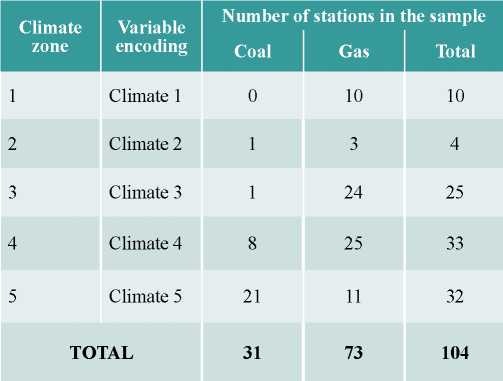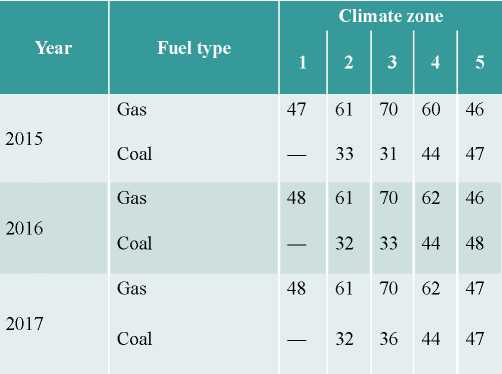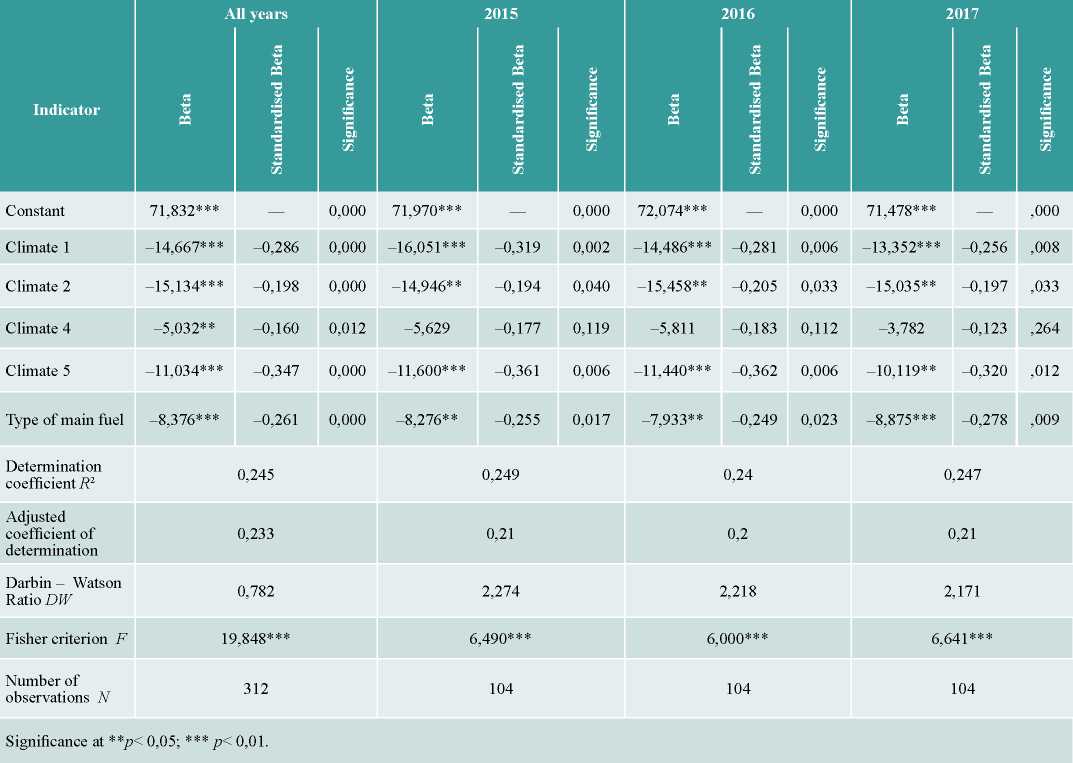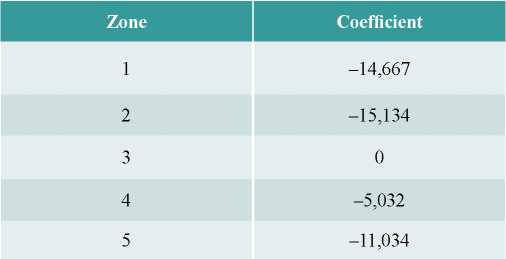Scroll to:
THE EFFECT OF EXOGENOUS FACTORS ON THERMAL POWER PLANT EFFICIENCY
https://doi.org/10.17747/2618-947X-2019-2-174-181
Abstract
This study focuses on the relationship between exogenous factors (that cannot be directly impacted by the actions of an economic agent) and combined heat and power (CHP) plant efficiency. As a measure of fuel utilization efficiency this paper proposes to use the Сoefficient of Fuel Utilization (CFU), which is the Russian equivalent of the Primary Energy Factor indicator. Climate conditions and fuel type were used as the exogenous factors in this article. Climate conditions were measured via climate zone proxies. The cause-effect relationships were analyzed using a linear regression model. The findings of the study showcase that the plants, which use natural gas as their primary fuel, show higher fuel utilization efficiency compared to coil plants. Climate conditions were also proven to be a statistically significant factor with plants situated in the third climate zone (mostly regions of the Central and North-Western federal districts) showing the highest average CFU of about 71%. The research shows that the exogenous factors account for close to 20% of CHP plant fuel utilization efficiency in Russia. The authors conclude that climate conditions and fuel type should be taken into account when constructing various energy efficiency models applicable to the Russian context.
Keywords
For citations:
Zolotova I.Yu., Karle V.A., Osokin N.A. THE EFFECT OF EXOGENOUS FACTORS ON THERMAL POWER PLANT EFFICIENCY. Strategic decisions and risk management. 2019;10(2):174-181. https://doi.org/10.17747/2618-947X-2019-2-174-181
1. INTRODUCTION
Increasing energy efficiency is one of the key priorities of the Russian economy. In electric power industry, the main direction of improving energy efficiency is to reduce fuel consumption in the production of electric and thermal energy, mainly in the mode of combined production. Thermal power plants producing both electrical and thermal energy account for about 70% of the total installed capacity of fossil fuel power plants.
Over the last 7 years, specific reference fuel consumption for electricity production has been reduced from 334.4 to 311.2 grams of fuel/kWh ( - 23 g, or 7%) for Russia as a whole (based on the proportional method of separation of fuel costs between electricity and heat energy) (Thermal Power Engineering, 2018). Target values of fuel efficiency of domestic energy are specified in the “Comprehensive plan of measures to increase the energy efficiency of the economy of the Russian Federation”, approved by Decree of the Government of the Russian Federation dated 19.04.2018 No. 703-r (Order, 2018). In particular, the planned indicator of specific reference fuel consumption for production of electric energy for the coming years is 300 grams of fuel/kWh ( - 10 g of the current level of 2021). For the long term, target value of specific fuel consumption is 255.6 grams of fuel/kWh by 2035. Thus, domestic energy sector faces a serious task of reducing specific reference fuel consumption over the next 17 years by more than 10%. Achieving such a result depends not only on the implementation of investment measures, but also on the implementation of approaches to loading power plants, optimization of regime-balance indicators. Furthermore, the improvement of fuel efficiency is inextricably linked to the development of a system of evaluation and monitoring of relevant indicators. To date, state regulation of infrastructure industries tends to a large- scale introduction of the reference principle in determining individual indicators of the functioning of business entities. The methodology of establishing common (reference) values of fuel efficiency indicators for power plants must be introduced within framework of the implementation of target strategic direction to increase energy efficiency of the country's economy.
In general, the standard is understood as extremely effective value, taking into account a number of objective exogenous factors. In this article, exogenous factors are factors, the presence and size of which cannot be influenced by economic entities. We consider the influence of individual external factors, including climatic conditions, on the fuel efficiency of domestic power plants. Inclusion of relevant variables in the benchmarking of fuel efficiency measures will prevent the adoption of unattainable fuel efficiency benchmarks in power plants.
2. ESTIMATION OF FUEL EFFICIENCY OF COGENERATION POWER PLANTS
In the combined production of electric and thermal energy it is accepted to distribute total fuel consumption between electric energy, released from the tires of power plants, and heat energy, released from collectors. In domestic practice, physical, proportional and “thermal” methods of separation are used for this purpose. In general, the choice of the method of distribution of fuel consumption between energy types rests with the regulated organizations/power plants.
All of these methods assume the estimation of fuel efficiency by type of energy produced (electricity or thermal energy). For comparison: the fuel efficiency of cogeneration stations abroad is considered as an integral indicator, taking into account both electrical and thermal energy. In the United States, fuel efficiency in combined production is assessed without differentiation by type of energy produced (Methods, [s.a.]). In particular, indicators of total system efficiency and Effective Electric Efficiency are used. The first indicator equates the contribution of electricity generation and heat generation to fuel efficiency. This approach is more appropriate to compare the efficiency of cogeneration stations of different types. In the European Union, Primary
Energy Factor is used to estimate the amount of resources used to produce a unit of electric/heat energy.
In domestic practice, the equivalent of such indicators is fuel utilization factor. With the help of fuel utilization factor the efficiency of cogeneration stations such as CHP is evaluated. For example, V. N. Churashev compared the activities of stations in Novosibirsk and Kemerovo regions due to the use of fuel utilization factor (Churashev, 2016). In the work of A. A. Gavrilova fuel utilization factor was used as one of three key indicators of efficiency of cogeneration plants along with electricity consumption for own needs and cost of generation energy (Gavrilova, 2015).
3. FUEL EFFICIENCY AND CLIMATE FACTOR
The Russian Federation is located in four climatic zones. This to a certain extent complicates the management of efficiency of key industrial complexes of domestic economy, including the branches of fuel and energy complex.
The influence of climate factor on the efficiency of power plants has been discussed repeatedly in the literature. When evaluating the efficiency of cogeneration power plants, it is necessary to take into account different duration heating period, temperature values in autumn-winter period, including peak zones of heat load and their duration. It is proposed to differentiate the subjects of the Russian Federation by structure and level of heat load depending on population density (Veselov, Volkova, Kurilov et al., 2010).
The climatic characteristics of the regions include:
- average temperature in the heating period;
- average annual duration of the period of freezing temperatures;
- period of negative temperatures in the heating period (Filippov, Dilman, 2014).
In the study of the efficiency of heating of domestic power plants E.A. Volkova and co-authors (Volkova, Makarova, Horshev et al., 2010) distributed them among five climatic zones taking into account climatic and geographical factors, which are closely related. Based on the design temperature of the external air, taken in the design of heating systems, the following zones are proposed: South (-20°C), Center (-25 °C), Ural-1 (-30 °C), Ural-2 (-35 °C) and Siberia (-40 °C).
The importance of taking into account the weather and climate factor is noted when studying the efficiency of cogeneration power plants in China, which also covers several climatic zones. To control the influence of weather conditions the regions of the country were divided into five climatic zones according to the national standard GB 50176-93. Based on average temperature values in January and June, the regions are allocated the following zones: severe cold, moderate cold, hot summers and cold winters, temperate climate, hot summers and warm winters (Jiang- Jiang, Chun-Fa, You-Yin, 2010).
Western scientists often find a slightly different approach to the analysis of the relationship between the climate factor and the efficiency of power plants. In the US and the EU, the challenge is to reduce negative environmental impacts from energy generation. The literature considers how effective power plants of different types will be in the conditions of global climate change (Allan, Eromenko, Gilmartinetal., 2015). American and European scientists consider to a greater extent the influence of fuel and energy complex on the state of the climate, rather than research the inverse dependence.
4. METHODOLOGY
In order to identify statistically significant relationships between external (exogenous) factors and fuel efficiency of domestic cogeneration power plants, we used linear regression the least-squares model. This approach allows to study the influence of one or more independent variables (factors) on the studied dependent variable (the resulting indicator). The least-squares method is often used by factor analysis in empirical economic studies within the fuel and energy complex (Suganthi, Samuel, 2012). Data on the results of domestic cogeneration power plants were obtained upon request from the Ministry of Energy of the Russian Federation (as part of the research work No. 18/0411.30703 90019.241 /09/210 in the interests of the Ministry of Energy of the Russian Federation).
4.1. DEPENDED VARIABLE
Taking into account the approaches to assessing the efficiency of fuel use in thermal power plants, we propose to use fuel utilization factor as a dependent variable. It represents the ratio of thermal and electric energy equivalents released from CHP to the thermal equivalent of burned fuel:

Where Eотi - is the volume of electricity released from the tires of the i-th power plant, MWh; Qотi - is the volume of heat output from the collectors of the i-th power plant, Gcal; Вi - is the amount of burned fuel, tonns of fuel oil equivalent, on i-th power plant..
4.2. INDEPENDENT VARIABLES
In order to take into account the natural and climatic specifics of the operation of power plants, location of power plants within a specific climatic zone was used (Resolution, 2010). Classification of regions of Russia by different zones depending on natural and climatic characteristics of the respective territories, including taking into account average temperature, humidity and other characteristics. The use of the zonal approach to the consideration of climatic features is quite common in foreign research. The power plant belongs to a specific climatic zone is taken into account in the model by introducing corresponding fictitious variables (Table 1).
In the first climate zone, only stations using gas as the main fuel type are presented. The third climate zone is also mainly represented by natural gas - generating stations. The fourth and fifth climatic zones have the largest number of stations, and in the fourth zone there are more stations where gas is used, while in the fifth - those that work on coal. In the second climate zone within the sample of the study there are the smallest number of stations. Taking into account the noticeable differences in the number of stations running on a particular fuel, we have introduced the additional exogenous factors in the form of dummy variables to control the influence of the factor “type of main fuel used”. If the variable is set to 1, the station uses mainly coal fuel, if 0 is natural gas.
Table 1
Description of the technical structure of power plants located in different climatic zones
4.3. DESCRIPTIVE STATISTICS
As part of the analysis, technical and economic indicators of 104 domestic power plants from 2015 to 2017 were analyzed.
The highest fuel utilization factor values are shown by the power plants located in the third climate zone (Table 2). The worst indicators show stations in the first and fifth climatic zones. In most climate zones, fuel utilization factor for power plants using gas and coal as fuel vary significantly. In some cases, stations using natural gas can show values 1.5 to 2.0 times higher than stations where coal is used as fuel.
Thus, theoretical description of the regression model will be as follows:
U = β0+ β1*climate zone + β2*fuel vide + έ, (2)
where β - is the corresponding beta coefficient of the independent variable.
In the framework of proposed factor analysis, the basic situation is considered the operation of the power plant located in the third climate zone (mainly the regions of the North-West and the Central Federal Districts) and using gas fuel.
Table 2
Fuel usage within climatic zones with specification of power plants by fuel type,%
5. RESULTS
As part of analysis, a model was built taking into account data for three reporting periods (2015 to 2017), as well as individual models for each year (Table 3). This approach makes it possible to analyze the sensitivity of models to changes in the number of observations. The obtained results are highly reliable, since all models show almost identical margin effects for the variables in question.
The results of regression analysis confirm statistically significant relationship between climate conditions, fuel type and fuel utilization factor. Power plants in the third climate zone that use gas as fuel, on average have a fuel utilization factor of 71 %, those that use coal - 8.3 p.p. lower.
The worst results are shown by the power plants located in the second climate zone, generating facilities located in the Republic of Kalmykia, Astrakhan, Pskov and Rostov oblasts (average fuel utilization factor is 56.7%). Almost identical deviation from the average fuel utilization factor value of the third climate zone stations ( - 14 p.p.) can be traced at the power plants of the fourth climate zone, which includes the subjects of the North Caucasus Federal District, as well as Krasnodar Krai and Kaliningrad Oblast. At 11 p.p. from the third climate zone, fuel utilization factor values are lower at power plants in the fifth climate zone (mainly the regions of the Siberian and Far Eastern Federal Districts). The value of fuel utilization factor of power plants of the third climatic zone is closer to the total power plant of the fourth climatic zone (Volga and Ural Federal Districts) (about 66%).
It is worth noting that the adjusted coefficient of determination for all models shows values from 0.2 to 0.23. Thus, the climatic factor and the factory-used fuel explain about 20 % of the distribution of fuel utilization factor values. Thus, it can be stated that 80 % of fuel utilization factor value depends on other factors not taken into account in the model. The amount of fuel utilization factor is significantly affected by the regime and balance loading of the power plant, as it determines the share of cogeneration power generation - the most effective mode of operation of thermal power plants.
Table 3
Influence of climatic factors on fuel utilization in power plants
6. PROPOSALS FOR THE MODEL OF METERINGOF FUEL EFFICIENCY INDICATORS OF POWER PLANTS
On the basis of the analysis the conceptual proposals for calculation of reference values of fuel utilization factor values for thermal power plants are formed. At cogeneration power plants fuel utilization factor is dictated by the structure of generating equipment used (Churarev, Markova, 2017). In many differences in efficiency and optimal load ranges (in accordance with regulatory and technical documentation) lead to different ratio of electric and thermal power.
In the framework of the proposed approach, the calculation of reference values of fuel utilization factor is carried out on the basis of initial nominal parameters of operating modes of generating equipment of the stations, technical documentation. Further, this conditionally effective indicator Uef is adjusted taking into account the type of fuel and climate zone. Thus, theoretical description of the proposed model of fuel utilization factor standards can be as follows:
Uэ.э =w1Uэф +w2Kкорр, (3)
where wn - is the weight value of the n-th factor in the calculation of the reference of fuel utilization factor. The results of regression analysis indicate that the value w1 can be 0,8, and w2- 0,2; Uэф - is the value determined on the basis of the analysis of the initial nominal parameters of operating modes generating equipment on the basis of normative and technical documentation on fuel use; Ккорр - is the coefficient reflecting the influence on fuel utilization factor of natural and climatic factors and the type of fuel, is determined by using a formula based on the results of regression analysis.
Kкорр = С + βк – 8,376 Fт, (4)
Where С - is a constant coefficient reflecting the level of fuel utilization factor in the third climate zone, С = 71,832 p.p. (the level of fuel utilization factor of the third climate zone is accepted as the best parameter in accordance with the calculations (Table 3) )); βк - is an indicator that takes into account the factor of the corresponding climatic zone (Table 4); Fт - is an indicator that takes into account the type of fuel (if natural gas is used, the indicator is taken equal to zero if coal — to one), p.p.
Table 4
Climatic factors for calculating Kкорр the definition of standard of fuel utilization factor for the power plants, p.p.
Application of this approach will allow for a more accurate determination of the calculated fuel utilization factor reference values for power plants, taking into account different climatic conditions and the design type of fuel burned by power plants.
7. CONCLUSION
Natural climatic conditions and the type of fuel used are significant exogene factors influencing technical and economic performance of power plants in terms of efficiency fuel use. Relevant factors are recommended to be taken into account when constructing analytical models for benchmarking fuel efficiency of power plants in Russia.
It is assumed that the estimated values of the benchmarks will be conditional on taking into account the system constraints and actual repairs determined on the basis of only one to three reporting years. In the future, it is necessary to update the relevant parameters, taking into account the changes in the constraints.
Among the future directions of research in this area is the justification of calculation of the reference values of fuel utilization factor on the basis of normative and technical documentation on fuel use. It is also necessary to study in detail the potential positive effect of the introduction of various energy-efficient technologies at fuel utilization factor power plants and their efficiency in general.
8. SPONSORSHIP INFORMATION
This article was prepared in the framework of scientific research work No. 18/0411.3070390019.241/09/210 in the interests of the Ministry of Energy of the Russian Federation.
References
1. Veselov, F. V., Volkova, E. A., Kurilov, A. E. et al. (2010). Metody i instrumentarij prognozirovaniya razvitiya elektroenergetiki // Izvestiya Rossijskoj akademii nauk. Energetika. 4:82–94 [Veselov F. V., Volkova E. A., Kurilov A. E. i dr. (2010) Electric energy development prediction methods and model. Russian academy of science bulletin. Energy. 4:82–94.(In Russ.).].
2. Volkova, E. A., Makarova, A. S., Khorshev, A. A. et al. (2010). Issledovanie effektivnosti razvitiyateplofikacii v Rossii // IzvestiyaRossijskoj akademii nauk Energetika. 4:95–110. [Volkova E. A., Makarova A. S., Horshev A. A. et al. (2010) A study of heat supply efficiency in Russia. Russian academy of science bulletin. Energy. 4:95–110.(In Russ.).].
3. Gavrilova, A. A. (2015). Organizaciya upravleniya energeticheskim proizvodstvom na osnove kompleksnykh kriteriev deyatelnosti // Vestnik Volzhskogo universiteta im. V. N. Tatishcheva. 1:11–16. [Gavrilova A. A. (2015). Managing electric energy production using composite indicators. Bulletin of Tatishev Volga University. 1:11–16.(In Russ.).].
4. Postanovlenie Pravitelstva RF “Ob opredelenii cenovykh parametrov torgovli moshchnostyu na optovom rynke elektricheskoj energii i moshchnosti” ot 13.04.2010 N 238 // Rossijskaya gazeta. 14 apr. [Act of Government of the Russian Federation N 238 “About setting price characteristics for power trade deals on the wholesale electricity market” from 13.04.2010.Rossijskayagazeta. April 14 (In Russ.).]. https://rg.ru/2010/06/04/elektro-site-dok.html.
5. RasporyazheniePravitelstva RF ot 19.04.2018. N 703-r “Ob utverzhdenii kompleksnogo plana meropriyatij po povysheniyu energeticheskoj effektivnosti ekonomiki Rossijskoj Federacii” // KonsultantPlyus [Act of Government of the Russian Federation N 703 “About the Master plan for increasing energy efficiency of the Russian economy” from 19.04.2018. Consultant Plus.(In Russ.).]. http://www.consultant.ru/document/cons_doc_LAW_296507/.
6. Teploenergetika i centralizovannoe teplosnabzhenie Rossii v 2015–2016 gody: Informacionno-analiticheskij doklad (2018) // Minenergo Rossii [Thermal energy and centralized heat supply in Russia 2015–2016: Analytical report. Russian Ministry of Energy.(In Russ.).]. https:// minenergo.gov.ru/node/10850/80685.
7. Federalnyj zakon “O teplosnabzhenii” ot 27.07.2010 g N190-FZ // Rossijskayagazeta. 30 iyulya [Federal Law N 190-FZ “About thermal power supply” from 27.07.2010.Rossijskayagazeta. July 30.(In Russ.).].https:// rg.ru/2010/07/30/teplo-dok.html.
8. Filippov, S. P., Dilman, M. D. (2014). Perspektivy ispolzovaniya kogeneracionnykh ustanovok pri rekonstrukcii kotelnykh // Promyshlennaya energetika. 4:7–11. [Filippov, S. P., Dil'man, M. D. (2014). Prospects for using CHP technologies in boiler construction. Industrial energy. 4:7–11.(In Russ.).].
9. Churashev, V. N. (2016). Kakim byt energoobespecheniyu Novosibirskoj oblasti // Interekspo Geo-Sibir. 3(3):60–65. [Churashev V. N. (2016). What are the possibilities for power supply in Novosibirsk region? Interexpo Geo-Sibiria. 3 (3):60–65.(In Russ.).].
10. Churashev, V. N., Markova, V. M. (2017). Malaya raspredelennaya energetika — novyj vector razvitiya generacii v sibirskikh regionakh // Interekspo Geo-Sibir. 3(2):75–81. [Churashev V. N., Markova V. M. (2017). Distribution energy systems — a new pathway of power generation in Siberian regions. Interexpo Geo-Sibiria. 3(2):75–81.(In Russ.).].
11. Allan, G., Eromenko, I., Gilmartin, M. et al. (2015). The economics of distributed energy generation: A literature review.Renewable and Sustainable Energy Reviews. 42:543–556.
12. Jiang-Jiang, W., Chun-Fa, Z., You-Yin, J. (2010). Multi-criteria analysis of combined cooling, heating and power systems in different climate zones in China. Applied Energy. 87(4):1247–1259.
13. Methods for Calculating CHP Efficiency ([s.a.]). United States Environmental Protection Agency. https:// www.epa.gov/chp/methods-calculating-chp-efficiency.
14. Suganthi, L., Samuel, A. A. (2012). Energy models for demand forecasting — a review.Renewable and sustainable energy reviews. 16(2):1223–1240.
About the Authors
I. Yu. ZolotovaRussian Federation
Director at the Center of Sectoral Research and Consulting, Financial University under the Government of the Russian Federation. Research interests: electric energy economics, pricing, investments in electric energy, government regulation of natural monopolies.
V. A. Karle
Russian Federation
Deputy director at the Center of Sectoral Research and Consulting, Financial University under the Government of the Russian Federation. Research interests: government regulation of natural monopolies, pricing, price prediction modelling, electric energy and other infrastructure sectors.
N. A. Osokin
Russian Federation
Deputy director at the Center of Sectoral Research and Consulting, Financial University under the Government of the Russian Federation. Research interests: econometric analysis, performance management, sports economics.
Review
For citations:
Zolotova I.Yu., Karle V.A., Osokin N.A. THE EFFECT OF EXOGENOUS FACTORS ON THERMAL POWER PLANT EFFICIENCY. Strategic decisions and risk management. 2019;10(2):174-181. https://doi.org/10.17747/2618-947X-2019-2-174-181













































